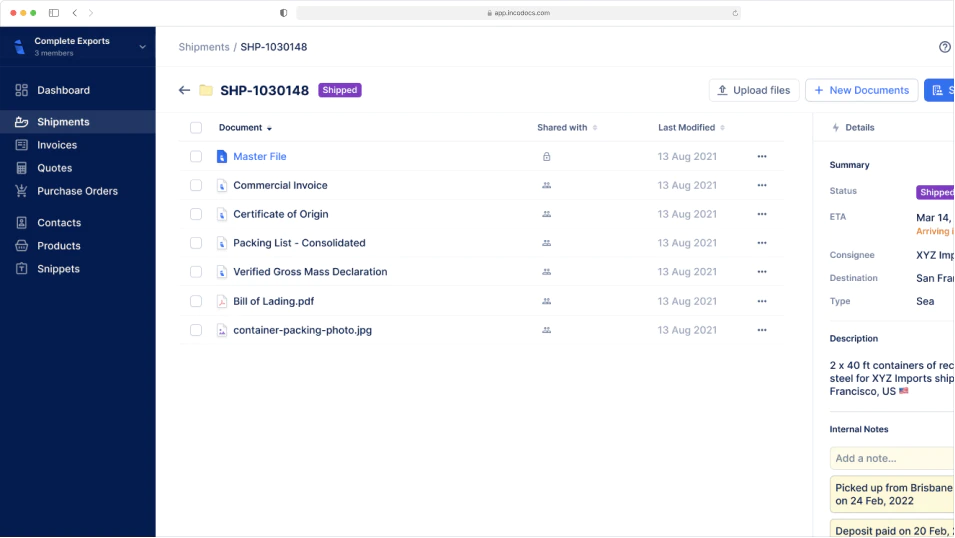IncoDocs raises $1.2M seed round led by Maersk GrowthRead the announcement

Form 6 Transboundary Movement Document Template
What is a Form 6 Transboundary Movement Document used for?
In 1989 the Basel Convention on the control of Transboundary Movements of hazardous wastes and their disposal was adopted. This was in response to the discovery of deposits of toxic wastes that were found in developing countries that were imported from other countries. As such, new regulations came into effect to protect human health and the environment against the adverse effects of hazardous wastes, and exporters shipping hazardous waste cargo were required to submit additional documentation. Read more about the Basel Convention here.
How to create a Form 6 Transboundary Movement Document
Open IncoDocs
Open IncoDocs in your browser and navigate to the “Export Docs” section.
Choose the Form 6 Transboundary Movement Document template
Click on 'New document set' and select the Form 6 Transboundary Movement Document template along with any other export documents you wish to create.
Fill out & customize your doc
Fill out the document, customize template fields to your needs and add your company letterhead. To save time and prevent re-entry errors, enter key shipment data into the Master File to have it sync across all other documents in your set automatically.
Sign & seal
Click on the signature box at the bottom of your document to create and place a digital signature then hit “Save & Quit”. On the document preview screen, click on the ‘More’ dropdown button and select “Add company seal” to place a digital stamp.
Download or share
Download or share documents from IncoDocs in 1-click. Documents can be downloaded as PDF or CSV which can be imported into other systems without manual re-entry.
Your questions, answered.
What information is included on a Form 6 Transboundary Movement Document?
It’s important that shippers include relevant information on the form 6 document so that the relevant customs departments and authorities can check and submit information as required. The details are to be provided by the exporter or importer of goods. Shippers, customs and relevant government departments will maintain records of the transport of these goods for historical use.
Some of the information to be included on a form 6 Transboundary Movement document includes:
What is the Basel Convention?
The Basel Convention is an international treaty designed to reduce the movements of hazardous waste between nations, especially from developed to less developed countries. It aims to minimize hazardous waste creation in terms of quantity and hazardousness. The treaty protects human health and the environment against the adverse effects of hazardous wastes. More details can be found on the Basel Convention's official page.
Why is the Form 6 Transboundary Movement Document necessary?
Form 6 ensures that the international movement of hazardous wastes is properly documented and controlled, in line with the Basel Convention's regulations. This helps prevent illegal dumping and ensures that hazardous wastes are managed safely and responsibly during import and export.
How has the Basel Convention been updated recently?
The Basel Convention has introduced electronic approaches to improve the notification and movement process of hazardous wastes. This includes digital signatures, electronic documentation, and better data exchange systems. These updates streamline compliance and enforcement, making the process more efficient. For more information, visit the Basel Convention's updates page.
What are R Codes and why are they important?
R Codes specify recovery operations defined under the Basel Convention. They indicate the method of recovery for hazardous waste, such as R1 for energy recovery and R2 for solvent reclamation. These codes ensure that wastes are treated and recovered in an environmentally sound manner at the recovery facility.
What happens if there is a violation of the Basel Convention regulations?
Violations can lead to penalties, including fines and legal action. Involved parties may need to return the waste to the country of origin or ensure its proper disposal. The Basel Convention provides mechanisms to address illegal traffic and ensure compliance. Detailed information can be found on the Basel Convention compliance page.
Additional Resources
View more information from the Organisation for Economic Co-operation and Development’s (OECD) Guidance Manual for the Control of Transboundary Movements of Recoverable Wastes.
Free to start,
Easy to use.
Setup in 5 mins.
